Second Language Acquisition and Second ... - Stephen Krashen
Second Language Acquisition and Second ... - Stephen Krashen
Second Language Acquisition and Second ... - Stephen Krashen
Create successful ePaper yourself
Turn your PDF publications into a flip-book with our unique Google optimized e-Paper software.
was said, which became a routine for Adam. After several weeks of hearing this,<br />
Adam was heard to say<br />
(2) Wait for it to dry<br />
when hanging up a washcloth. Also, many of Adam's long sentences were the result<br />
of juxtaposing existing routines. For example,<br />
(3) I want you to get a biscuit for me<br />
consists of the pattern "I want _______" plus the underlined portion, which existed<br />
as an independent routine for Adam.<br />
Clark claims that routines <strong>and</strong> patterns were primary in Adam's development of<br />
language: "In Adam's speech at this time a number of routine sequences seemed to<br />
coexist with a few simple productive rules. Many, though not necessarily all, the<br />
productive rules originated as invariable routines, which were in use for some time<br />
with the original lexical items before new lexical items were inserted" (p. 4). Thus<br />
Clark, while not denying the existence of a separate creative construction process,<br />
supports position 3 as the central means for language development for Adam. This<br />
seems to be in conflict with Brown's conclusion.<br />
The work of A. Peters (1977) helps to resolve this apparent conflict. Peters<br />
distinguishes "analytic" <strong>and</strong> "gestalt" styles of first language development. The<br />
analytic style, which is used for referential, labeling functions, is the "one word at a<br />
time" development described in most studies of child language acquisition, such as<br />
those by Brown <strong>and</strong> his co-workers. The "gestalt" style, on the other h<strong>and</strong>, is the<br />
attempt to use whole utterances in a socially appropriate situation; it is thus used in<br />
more "conversationally defined" contexts. Peters suggest that there is individual<br />
variation among children as to which style will predominate. One of the factors that<br />
may determine which style a child will prefer is input type: the "analytic" child may<br />
have received clear caretaker speech, while the "gestalt" child may have received<br />
more rapid, conversational input.<br />
A given child may use one style for one situation <strong>and</strong> the other for other situations:<br />
Peters' subject Minh appeared to speak analytically when naming, <strong>and</strong> used the<br />
gestalt style for social functions. Other investigators (Dore, 1974; Nelson, 1975)<br />
have also noted this kind of<br />
88











